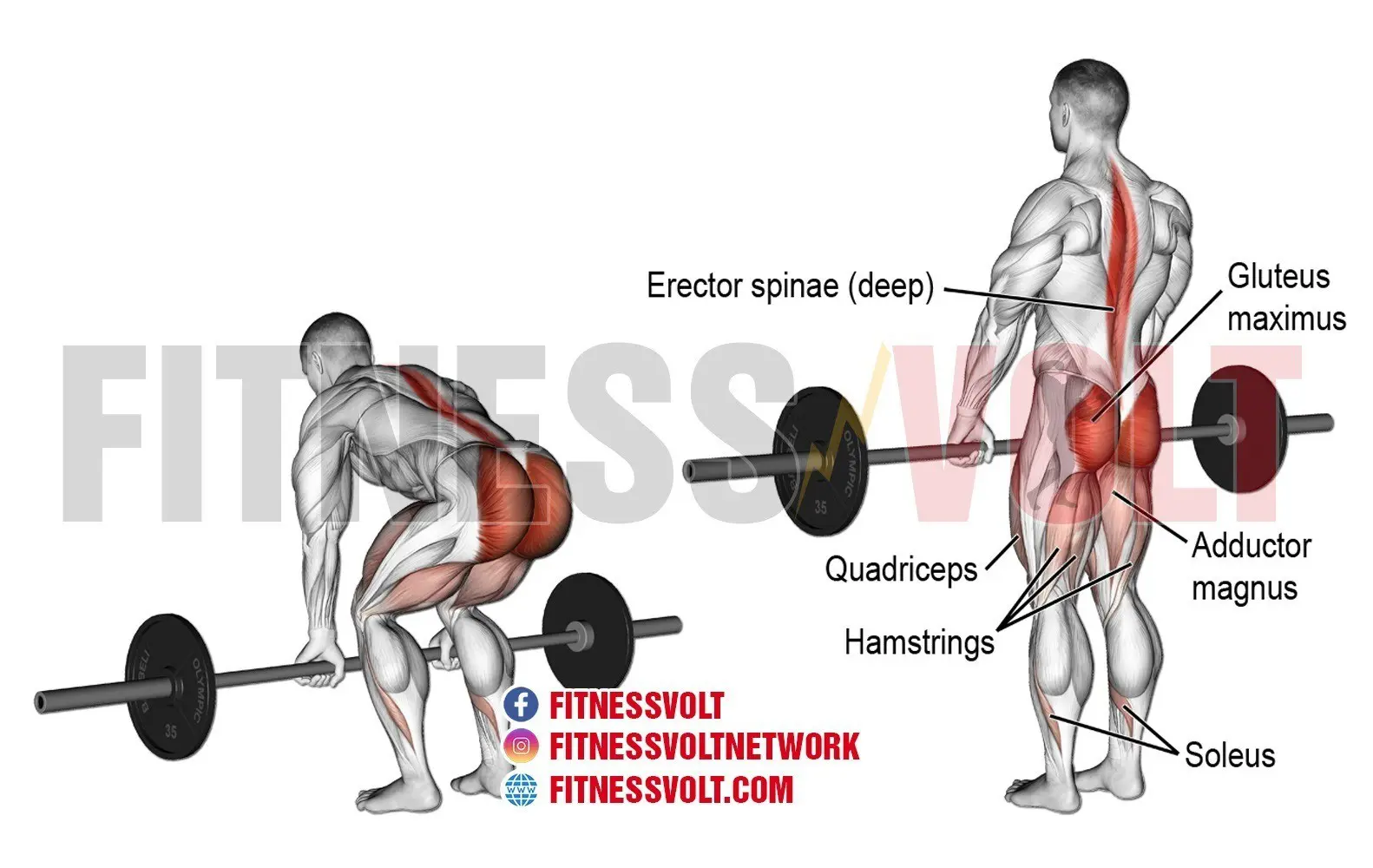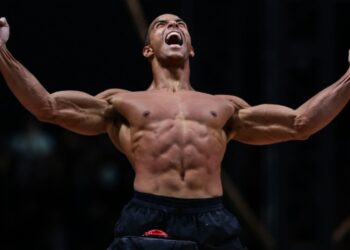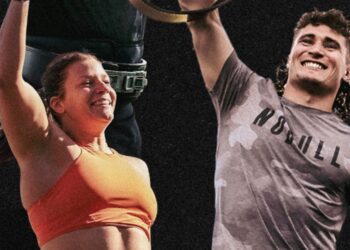To be successful in CrossFit (competitively or recreationally), you must know which exercises are the most important and how to progress with each one of them.
So, we’ve put together a guide detailing the bread and butter exercises with step-by-step instructions so that the process will be as smooth for you as possible!
1. Barbell Deadlift
If you want to be an absolute beast among beasts then you must learn how to perform the deadlift because it involves most muscle groups and will really challenge you more than most others. And no other exercise in existence allows you to lift such a maximal amount of weight all in one movement.

Therefore, it’s a massive strength builder that requires a lot of stamina and mental fortitude. And the ability to perform this exercise effectively relies heavily on an effective lower and upper kinetic chain of movements.
According to studies, multi-joint closed kinetic chain movements like the deadlift; have the ability to maximally recruit muscle fibers, improve neuromuscular coordination, and is very functional with carryover to other movements. (1)
And this is in comparison with single-joint open kinetic chain movements like the barbell curl for instance.
Level Up Your Fitness: Join our 💪 strong community in Fitness Volt Newsletter. Get daily inspiration, expert-backed workouts, nutrition tips, the latest in strength sports, and the support you need to reach your goals. Subscribe for free!
Deadlift benefits
- Works entire posterior chain (backside of the body) plus core, biceps, and forearms
- Insane strength increases
- Improved explosiveness and power
- Provides closed kinetic chain benefits
How to do the deadlift
The deadlift is performed with the loaded barbell on the floor. And you’ll need to start small to get the proper form down before even considering using a challenging amount of weight.
Now, the movement involves bending your torso forward slightly away from your center of mass to lift the barbell off of the ground. So, it’s crucial that the barbell is kept as close to your body as possible while maintaining a straight back to prevent excessive stress on the spine and injury to the back.
Your hips should thrust forward as you pull the bar upward using your legs so that you can effectively complete the movement. So, by no means should your back be doing the pulling because you’d be asking for serious problems.
Here are step-by-step instructions with a video example…
- Walk up as close to the bar as possible with a hip-width stance.
- Bend your knees and squat down while keeping your thighs above parallel to the floor.
- Then grip the barbell with hands slightly wider than hip-distance apart and make sure your back is completely straight with shoulder blades pinned back.
- Take a deep breath and tighten your core muscles.
- Drive the weight up by pushing through your heels and midfoot while pulling the weight upward by also engaging your lats. Keep your chest up.
- When the bar reaches the knee level, thrust your hips forward to finish off the movement into a standing position and exhale. Then repeat.
Important tips:
- Keep the bar as close to your body as possible. This is necessary for back safety and optimal performance.
- Thrust the hips forward as soon as you’re able, to effectively finish and lockout the movement.
- Keep your shoulder blades retracted and maintain thoracic extension to protect your neck and shoulders.
2. Barbell Back Squat
The back squat is a must for maximum lower body power and explosiveness but it’s also a staple exercise for CrossFit training and performance. And few exercises build the quads like this powerhouse movement. (2)
But the posterior chain is also heavily engaged as well as the core muscles. And a thoracic extension of the torso is also a very important component for performing the back squat correctly. (3)
Back squat benefits
- Huge muscle mass improvements
- Large lower body strength increase
- Improved core stability
- Explosiveness and power
How to do the back squat
Form is imperative here since you’re essentially supporting the weight load on your trap. So, keep a straight posture and your head should be forward.
Here are step-by-step instructions with a video example…
- Position yourself beneath the bar where it’s placed on a neutral spot on your traps while keeping a relatively straight posture.
- Spread your feet wider than hip-width and turn them only slightly outward.
- Make sure your knees are not positioned forward over your feet. They should remain aligned with your heels as much as possible.
- Unrack the bar and walk backward keeping your chest and head up looking forward.
- Maintain the same foot and body position, then squat down past parallel and inhale.
- Drive back up by pressing through your heels and midfoot while you exhale.
Important tips:
- Keep your head straight and look forward during the movement.
- Never allow your knees to move past your feet.
- Maintain a neutral position. Don’t lean too far forward or backward.
3. Barbell Front Squat
The barbell front squat is a variation where you perform the movement with the bar across your clavicles resting on your anterior (front) deltoids. And if you’re going to maximize your squat performance then the front squat is very necessary.
But it’s not just a variation of the back squat. The front squat is actually a good movement for pinpointing any areas which need to be improved to be more efficient with the exercise.
A thoracic extension is crucial for being able to do this movement optimally, and if you have any joint mobility issues; they will be quickly identified in which you can take action to improve these restrictions.
But the front squat doesn’t only benefit lower body progress. Since the exaggerated thoracic extension is required during the movement, your posterior chain is highly engaged to support the movement pattern. The spinal erectors of the back are one of the main muscle groups involved for the upper body.
The front squat is also just as effective as the back squat for muscle activation but the former results in less compressive forces and extensor moments. Whereas the back squat involved more knee extensor moment and compressive forces. (4)
So, overall, the front squat is beneficial for people with knee issues and long-term joint health.
Front squat benefits
- Increased muscle size
- Improved strength performance
- Functional improvement
- Improved thoracic extension
- Effective identifier of limitations
How to do the front squat
Like mentioned previously, the thoracic extension is a crucial component of an effective front squat. And not because you have to maintain the bar across the front deltoids, but not doing so can severely injure your back.
You must remain more upright than you would a back squat and we’ll provide an example of how to do it safely and effectively.
Here are exercise instructions with a video example…
- Extend your arms straight out in front of you to determine hand width placement on the barbell and position yourself under it so that the bar is resting comfortably on your front deltoids across your clavicle area.
- Now, grip the bar so that your elbows are pointing directly in front of you. Your upper arms should be parallel to the floor.
- Unrack the weight, walk backward and keep your feet pointed slightly outward with a wider than hip-width stance.
- Maintain an upright chest and vertical body position, then squat straight down as far as you can and inhale.
- Drive the weight upward through your midfoot and heels while you exhale.
Important tips:
- You want your body to remain vertical so that your butt is not moving back like with the back squat. The elbows should never drop down which would drop the weight forward and overbend your wrists.
- Avoid crossing your arms when you grip the bar if possible because it’s not an ideal position for carryover into CrossFit movements like cleans and thrusters.
- The bar should maintain a straight line from its placement on your shoulders to your hip crease.
4. Barbell Bench Press
The barbell bench press is a superior upper body exercise which involves all pushing muscles (chest, triceps, and shoulders). And this power movement is undoubtedly the standard by which upper body strength is measured.
The flat bench press effectively works both the lower and upper chest equally which makes it the preferred upper body pressing movement. (5)
But there’s more to this exercise than just hopping on the bench, and pressing the bar up and down. The legs help to drive the weight upward and latissimus dorsi involvement is also important to ensure a proper movement pattern and perfect technique; which can make or break your success.
Bench press benefits
- Improved upper body strength
- Works all pushing muscles
- Can lift maximum loads
How to do the bench press
Several muscles are involved in the movement, so you’ll need to know a few things in order to effectively position your body to press the bar with maximum strength capability. Your feet should provide a stable base to drive more force through the lower to upper kinetic chain; which will lead to maximal performance.
And your lats should remain tight with a rounded back to minimize the range of motion. But you should develop a pre-lift ritual; which you can routinely perform to ensure you’re able to get into position the same way every time.
Then you should use the bar to swing your body into position so that you can have a perfect lift-off and positioning before you perform the press. And your wrists should be as straight as possible to prevent them from bending backward which will sabotage your lift.
Level Up Your Fitness: Join our 💪 strong community in Fitness Volt Newsletter. Get daily inspiration, expert-backed workouts, nutrition tips, the latest in strength sports, and the support you need to reach your goals. Subscribe for free!
Check out the step-by-step with a video example…
- Lie back on the bench and grip the bar comfortably, slightly wider than shoulder-width.
- Swing yourself into position and pin your shoulder blades while arching your back and keep your feet planted on the floor.
- Tuck your elbows in slightly and tighten your lats.
- Try to pull/slide the bar off of the rack rather than pushing upward and hold it over your lower chest/sternum area.
- Lower the bar to your sternum with thoracic extension and inhale.
- Press the bar up and slightly back in a slight arch motion keeping the lats tight and exhale.
Important tips:
- Keep elbows tucked in and lats tight for maximum pressing power.
- Slide the bar off of the rack by pulling it toward you, rather than just pushing it up.
- Press the bar upward and slightly back in an arch motion which is more natural for the body.
- Keep your back arched and feet planted on the floor.
- Always keep your shoulder blades together to prevent losing proper form.
5. Barbell Overhead Press
The overhead press is another essential upper body movement that really tests deltoid power and strength. But, the ability to lift a massive amount to overhead requires more than just shoulder power.
Your legs, core, chest, triceps, and back muscles must all engage to force the barbell upward.
Overhead press benefits
- Huge upper body strength and power
- Builds shoulder and tricep muscles primarily
- Core stability and strength
- Leg power
- Carryover into other power movements which require overhead presses
How to do the overhead press
You want to be able to get in a position where you can generate maximum power. So, your stance should be about hip-width.
Here are the exercise instructions with video example…
- Walk up to the bar set at upper chest level
- Unrack the bar with hands about hip-width distance apart and walk backward so the bar is resting below the chin.
- Your feet should be about hip-width.
- Keep your core tight and back straight so that you’re perfectly balanced and inhale.
- Drive your heels through the ground, squeeze your glutes and press the bar directly overhead moving your head out of the way and exhale.
- Lower the bar down to your upper chest and repeat.
Important tips:
- Keep your knees slightly bent to alleviate backpressure.
- Keep the bar as close to your body as possible.
6. Snatch
The snatch involves a powerful and quick, explosive movement utilizing a full kinetic chain of actions to pull the bar from the floor overhead.
The snatch is very beneficial for developing explosive power for athletic performance, strength, coordination, stability, muscle growth, balance, and it has a lot of carryover into other power movements.
It works the entire posterior chain (backside of the body) of muscles plus the core and the pushing muscles of the arms as well. Not to mention, it can help to improve joint stability in the hips and ankles through the movement which requires flexibility from both joints.
How to do the snatch
It’s very important that you keep the bar as close to your body as possible in order for you to be able to successfully lift it overhead.
Exercise instructions…
- Take a slightly wider than hip-width stance with feet and knees pointed slightly outward. Toes should be under the bar.
- Grip the bar a bit wide to minimize the distance the bar has to travel overhead.
- Make sure shoulders are positioned over the bar.
- Drive upward through your heels and midfoot and pull the bar upward into a high pull to about mid-chest level, then thrust your hips up to help launch the weight upward overhead while lifting your heels off of the ground into the last position.
- Dip down under the bar into the bottom of a squat position and then squat all the way upholding the weight overhead.
Important tips:
- Keep your feet and knees pointed in the same direction to avoid hitting the bar on your knees. This foot position is also safer and more natural during the movement.
- Placing your shoulders over the bar will allow you to pull the bar up with enough force to complete the lift overhead.
- Use your hips to help shoot the bar upward.
7. Clean and Jerk
The clean and jerk are two separate movements but this exercise actually involves both together. And the success of this movement is highly dependant on a closed, full kinetic chain of movement, so it’s not easy by any means.
You have to lift the bar from the ground into a front squat position and then press it overhead. And there are many benefits to the clean and jerk from the obvious performance improvement, to better coordination, explosiveness, and full-body conditioning.
Clean and jerk benefits
- Explosive power development
- Full-body coordination
- Increased stability and core strength
- Metabolic conditioning
How to do the clean and jerk
Every component involved in the clean and jerk must be maximally utilized to ensure a successful lift. Your leg drive, core strength, momentum, and lift overhead must be all in sequence.
Here are the step-by-step instructions…
- Placed your shins as close to the bar as possible, bend down keeping your back straight and slightly bent over.
- Grip the bar on the outside of each leg and drop your hips so that your shoulders are over the barbell.
- Keep your core tight and begin to lift the barbell off the ground quickly by driving upward through your heels and midfoot. Pull the bar toward your body, not straight up and keep your shoulders just over the bar.
- Then as the bar passes the knees, shrug your shoulders and explosively thrust the hips forward to shoot the bar off of your hips. Jump up at the same time you pull the bar upward heels first.
- Pull yourself underneath the bar so it’s on your front deltoids in a front squat position.
- Take a moment to balance yourself.
- For the jerk, keep your core tight, then dip down to get power from your legs.
- Press and drive upward through your legs so that your feet leave the ground.
- Then finish the press using your arms.
Important tips:
- Make sure to pull the bar up toward your legs and keep your shoulders over the bar.
8. Pull-Up
The pull-up is an excellent upper body movement that requires maximum effort from the pulling muscles (back and biceps) while you also need sufficient grip strength. But the movement can actually improve grip strength the more you advance with the exercise.
This powerful exercise is different from most seeing as you’re hanging from the bar and not able to use your feet as a base for power and assistance. And this variation is different from the chin-up where you use an underhand grip to target more of the biceps.
Pull-up benefits
- Increased upper body strength
- Works entire upper posterior chain of muscles
- Bodyweight movement
How to do the pull-up
- Grip the bar so your hands are about shoulder-width distance apart from each other (Or just slightly wider). Use an overhand grip with elbows slightly tucked inward.
- Bend your knees and allow your body to hang freely while your arms are extended from the bar. Then inhale before you begin the pull-up.
- Tuck your elbows in slightly, and then pull yourself up as high as you can while exhaling.
- Lower your body back down until your arms are extended and inhale.
Important tips:
- Keep your elbows slightly tucked in to get the most strength performance out of the exercise.
- Avoid swinging your body to complete the pull-up.
9. Overhead Squat
At first glance, the overhead squat appears to be a balancing act (And it definitely is to an extent) but it really tests your stability, static strength, mobility, coordination, and muscular endurance.
You must know how to squat properly and you need to be able to hold a barbell overhead in a static position for balance during the movement. This exercise works the posterior chain plus the core and arms muscle which assist during the movement.
How to do the overhead squat
Shoulder position and core stability are largely important components of the overhead squat. And body awareness is also crucial which means an effective overhead squat should be developed through a lot of practice due to the balance required.
The bar should remain over your heel without compromise so it’s good to have someone there to guide you to ensure you’re performing the exercise properly and safely.
Exercise instructions with video example…
- Take a wide grip and slightly wider than hip-width stance. Knees and feet should be pointed slightly outward.
- When overhead the bar should be aligned with your heel.
- Keep your core tight and squat down so your thighs are slightly below parallel but pull the bar slightly back to ensure it stays in line with your heels.
- Squat upwards through your heels and push up through your shoulders while arms are extended until you’re standing erect.
Important tips:
- Always keep the bar in line with your heels.
- Pull the bar slightly back during the squat to ensure it stays in the proper position.
- Your feet should be slightly pointed outward in the same direction as your knees.
10. Burpees
The burpee will make any grown man want to cry because it’s a toughie but we know that the harder something is, the more benefit you can get out of it.
This awesome exercise combination involves a push-up and jump squat all in one. So, being proficient in both is highly recommended for the best performance possible.
Burpee benefits
- Improved endurance and stamina
- Full-body conditioning/cardio-building
- Increased muscle mass and strength
- No equipment necessary
How to do the burpee
- Jump into a push-up position
- Perform the push-up and move your legs up so that you’re into the bottom of a squat position on the balls of your feet.
- Jump into the air explosively then after you land, repeat the movement.
Important tips:
- Get into a good rhythm which will help you perform the exercise more efficiently.
- Both movements should be explosive.
11. Wall Balls
This brutal exercise is a real test of strength, endurance, and mental capacity. You’re simply squatting down to throw a medicine ball at the wall, then you’ll catch it. And you could just imagine how challenging it would be to do this over and over again.
There’s not a whole lot to this exercise but you can challenge yourself by using a heavier ball or throwing it higher up on the wall.
Wallball benefits
- Improved cardiovascular endurance
- full -body conditioning
- Multiple ways to increase the difficulty
How to do wall balls
- Pick up the ball so your palms are facing upward and your fingers are pointed toward your face and hold it against your chest.
- Squat down and as you drive your weight back up as you would a regular squat, throw the ball upward against the wall.
- You’ll then catch the ball and repeat.
Tip: Use a heavier ball or try to toss it even higher as you progress.
Wrapping Up
These are 11 exercises that everyone involved in CrossFit training should learn proficiently. They’re staples and the better you are at them, the more you can be assured that your performance will be up to par if training at maximum potential consistently.
Follow the instructions and make sure to maintain properly for maximum safety and performance. How you perform an exercise will highly determine your ability to execute it effectively.
But the most important thing is that you start slowly and learn the exercises the right way. And one thing to note is that proper form can be different for everyone but the basic principles of safety remain the same.
Discover what works best for you and you’ll definitely make amazing progress.








